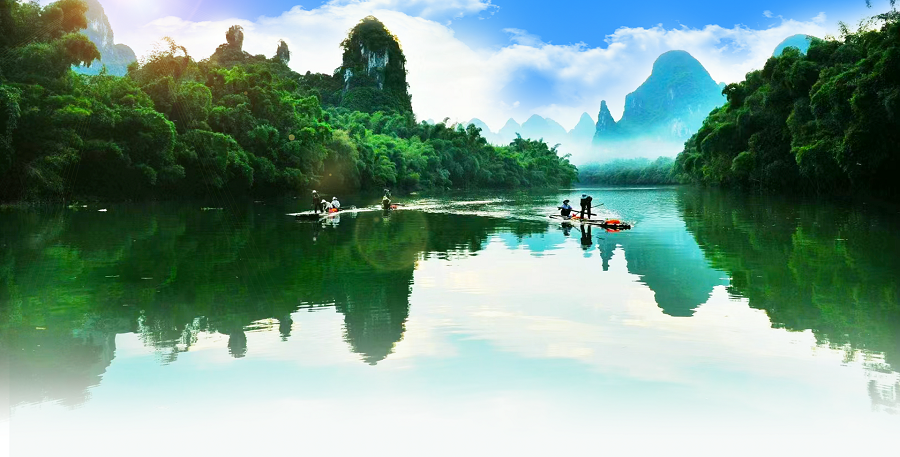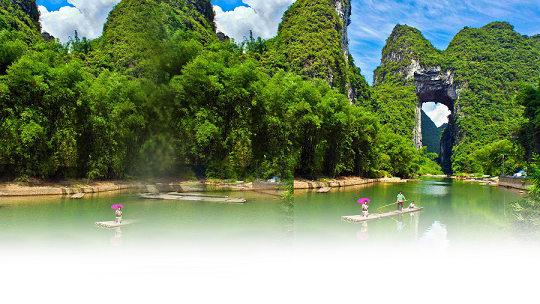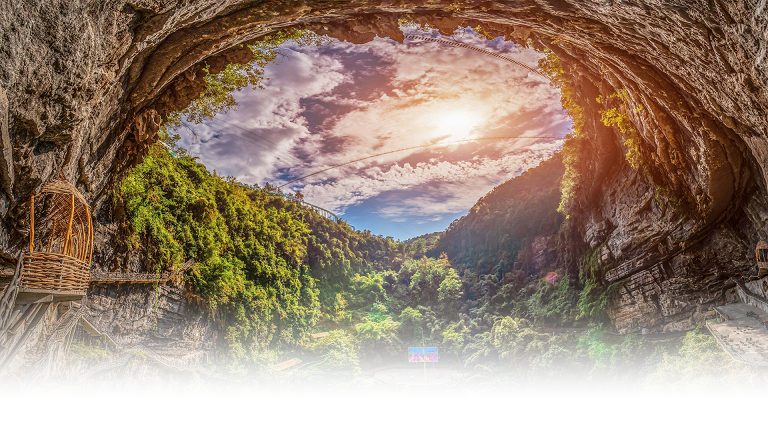Luocheng County
中文
- Profile Jurisdictions GOV DEPARTMENTS Cultures Travelling Educate
- Mulao Autonomous County of Luocheng is located in the north of Guangxi, east of Hechi City. There are Zhiliu Railway (Niu Bi Railway Station), Ronghe Expressway, S507 (Jinxiu to Luocheng), G357 (Rongshui to Luocheng), G242 (Rongshui to Luocheng), and Wuyang River, Dongxiao River, Jianjiang River, etc. The transportation is convenient. It has 7 towns and 4 townships under its jurisdiction, with the People's Government of the autonomous county stationed in Dongmen Township, and an administrative area of 2,651 square kilometers.At the end of 2023, the county had a total household population of 384,400 people, of which 121,000 people were registered in cities and towns. There are Mulao, Zhuang, Yao, Miao, Dong and other ethnic minorities, and the natural population growth rate is -1.3 per thousand. The annual crop sowing area is 64,891 hectares, grain planting area is 23,811 hectares, oil crops planting area is 3,412 hectares, sugar cane planting area is 11,436 hectares, and vegetable planting area is 17,302 hectares. The mileage of graded highway is 1,701 kilometers, of which 261 kilometers are secondary highway. The main tourist attractions (points) are Cotton Sky Pit (4A), Shiwei Ancient Village, Dale-dong Ancient Village, Yu Chenglong Ancient Road, Mulao Museum, Yu Chenglong Integrity Culture Exhibition Hall, Chenglong Lake Park, Qingming Mountain Manor, Jianjiang Scenery, Cailong Waterfalls, Tianmen Mountain, Sleeping Beauty, Wuyangjiang Scenic Spot, Acacia Grove on the Water, Misui Grove Resort, and Bao Tan Primitive Forest Natural Reserve, of which the Cotton Sky Pit is a national-level tourist Scenic spot 2023 annual reception of 450,900 tourists, 2023 county total number of tourists 2,803,600 people, the total tourism consumption of 2.859 billion yuan. The county star hotel 1, Guangxi landscape hotel 1: 2 travel agencies; star Nongjiale 8; A-class tourist attractions (points) 8, of which 3 AAAA level, AAA level 2. Important mineral resources are coal, iron, tin, copper, nickel, antimony, lead and zinc, gold, sulfur, silicon, crystals, barite, the famous local products are wild woolen wine, Tianlongquan wine, roasted cigarettes, tea, mushrooms, black fungus, beef strips, dry cutting powder, golden jade pomelo, red garlic, pearl glutinous corn head, Jiuzi million, Jiuzi million mountains, Naweng, wild plantain, Guijingshan spring water and so on. It is the hometown of wild hairy grapes in China, the hometown of non-ferrous metals in Guangxi, the hometown of coal in Guangxi, the pilot county of the national cultural information resources sharing project, the county of the “Twelfth Five-Year Plan” of national support for the development of ethnic groups with small populations (Mulao), the demonstration county of Guangxi's under-forest economy project, and the “earthless resettlement” county of Guangxi's relocation of poverty alleviation based on the development of urbanization. It is also the planning county for the “landless resettlement” project. It is also the birthplace of Liu Sanjie, the Zhuang singing fairy, and the birthplace of Yu Chenglong, an incorruptible official in the Qing Dynasty.
Natural Resources] In 2023, the annual crop sowing area was 62,858 hectares, and the annual supply of state-owned construction land in the county totaled 49.89 hectares. The county completed afforestation of 867.33 hectares in the year, with a forest area of 189.54 thousand hectares and a forest coverage rate of 71.44 %. The total water consumption of the county for the whole year was 164 million cubic meters. Among them, domestic water consumption was 0.19 billion cubic meters, industrial water consumption increased by 0.01 billion cubic meters, and agricultural water consumption was 143 million cubic meters. Per capita water consumption was 602.2 cubic meters. The average annual temperature is 19.5 ℃, the average annual precipitation is 1540.8 millimeters.
The history of Luocheng is long. It belonged to Guilin County in Qin. Han belongs to Tanzhong, Dingzhou two counties. In the Three Kingdoms and the Two Jin dynasties, it belonged to Tanzhong County. The Southern Dynasties (533 years) set up Huangshui County, the beginning of the county. Sui Kaihuang eleven years (591 years) set up Lin She County; Daye two years (606 years) Huangshui, Lin She abolished into the Yi Xi County, belongs to the Yi Xi County. Tang Wude four years (621 years) set Anxiu County, reset Huangshui County, Lin She County; Zhenguan four years (630 years) added Tianhe County. Song Kaibao five years (972) set Luo Cheng County, get the name of the county. November 23, 1949, February 23, 1950 Luo Cheng County, Tianhe County has been liberated. July 1952 to withdraw the Tianhe County and Luo Cheng County.
Regional Division] Lucheng is located at the southern foot of the center of Guibei's Jiwan Mountain, where the climate is pleasant, with no severe cold in winter and no scorching heat in summer, the development of karst geomorphology, and the integrity of the natural ecology, as well as the first hometown of the famous Southeast Asian singing fairy, Liu Sanjie, is located here, which adds even more fascinating natural colors to the already magical land of Lucheng. The characteristics of tourism resources of Mulao Autonomous County can be summarized as follows: rich ethnic customs and mountains, beautiful water, strange caves, beautiful rocks and abundant materials. According to the survey statistics and categorization in accordance with the provisions stipulated in the “China Tourism Resources Census Specification” compiled by the Department of Resource Development of the National Tourism Administration and the Institute of Geography of the Chinese Academy of Sciences, there are more than 50 kinds of tourism resources in Lucheng in total in 2 categories and 16 subcategories. On August 30, 1983, the State Council approved (State Letter [1983] No. 172) the abolition of Luocheng County and the establishment of Mulao Autonomous County of Luocheng, which was formally established in January 1984, with the administrative area of the former Luocheng County as the base. The administrative area of the former Luocheng County is the administrative area of Mulao Autonomous County. Administrative divisions of Mulao Autonomous County (7 towns and 4 townships): Dongmen Town Under the jurisdiction of Dongmen Town, there are 5 communities, namely Qiaotou, Fenghuang, Shishishan, Baima and Wulixiang; and 19 village committees, namely, Chongdong, Dazhuang, Sanjia, Yantang, Dafu, Lerao, Guyao, Deyin, Pingluo, Zhangluo, Yong'an, Fenghuo, Hengshang, Zhongshi, Yudong, Dongyong, Nongda, Longshan, and Rongmu. Longan Township, under the jurisdiction of: Longan Community; Ping Shi, Beiyuan, Tianbao, Muhua, Damon, Taihe, Gao'an, Lotus, Longfeng, Longping, Yamaguchi, Sipan, Zhujiang, Rongshan, Sanling, Bailian 16 village committees. Golden Township, under the jurisdiction of: Golden Community; Temple, Baoju, Zhaibei, Zhaidao, Yihe, Beisheng, Youdong 7 village committees. Small Chang'an Township jurisdiction: Chang'an community; return to Ann, Shuanghe, Longteng, Hepei, Luodong, Shouxian, Niu Bi, under the Wu, national, Lixin, Shuangmeng 11 Village Committee. Sizhu Township, under the jurisdiction of: Sizhu Community, Rining Community; new India, Daxin, Siping, Sumin, Siai, Dereneng, Shimen, Longma, Shuangzhai, Dashan, Dimen, Gantang, Jihuan, Cotton, Risheng, Rile, Rijiang, Ma'an, Changchun, Xin'an, Datong, 21 village committees. Tianhe Township, under the jurisdiction of: Tianhe Community; Gubang, Bairen, Jiaquan, Jinxin, Huazhang, Hangshui, Tunxiang, Weixin, Beihua, Jinxing, Jincheng, Bei'an, Jicheng, Shangchao 14 village committees. Huaiqun Township, under the jurisdiction of: Huaiqun Community; Dong'an, Siban, Jianjiang, Gogang, Lun Dong, Jia Bowls, Shrimp Cave, Ziqiu, Keng Yao 9 village committees. Bao Tan Township, under the jurisdiction of Bao Tan Community; Lalang, Sibao, Zhuangdong, Xihua, Zhaocen, Wudi, Binh Duong 7 village committees. Qiaoshan Township, under the jurisdiction of Qiaoshan Community; Qiaoben, Gujin, Gucheng, Dacheng, Iwakou, Panchuan 6 village committees. Nayon Township, under the jurisdiction of Nayon Community; 5 village committees: Banyang, Kencai, Dongmin, Shefu and Minzu. Cian Ai Township, under the jurisdiction of Daban Community; 10 village committees: Zhen'an, Gan Feng, Danxing, Cian Ai, Dilong, Zhenxin, Qing'an, Dazhu, Dingsin, Dong Hang.
Comprehensive economy] In 2023, the gross regional product (GDP) will be 8.413 billion yuan, of which the added value of the primary industry will be 3.155 billion yuan, the added value of the secondary industry will be 1.464 billion yuan, and the added value of the tertiary industry will be 3.794 billion yuan. Per capita GDP is 31,213 yuan. Fiscal revenue of 568 million yuan, of which 331 million yuan of general public budget revenue; general public budget expenditure of 3.765 billion yuan. Investment in fixed assets increased by 55.9% year-on-year. Total retail sales of consumer goods increased by 2.5% year-on-year. Per capita disposable income of urban residents was 30,313 yuan, and per capita living consumption expenditure of urban residents was 17,157 yuan. The disposable income per capita of rural residents was 12,510 yuan, and the per capita living consumption expenditure of rural residents was 8,386 yuan. The balance of household savings deposits at the end of the year is 11.28 billion yuan.
Tourism Resources] Located in the south of Lingnan in China, at the southern foot of Jiwan Mountain in northwest Guilin, Luocheng is the only Mulao Autonomous County in China. It is close to Guilin in the north and Liuzhou in the south, with very convenient transportation. The special karst geological landscape, native natural environment and rich ethnic minority flavor have formed a rich tourism resource with natural scenery, humanistic landscapes and folk customs.
Natural landscape: Lucheng has a typical “karst” geomorphology with dense mountains and valleys. Within the scope of both comparable to other domestic karst areas karst peak forests, peaks and clusters of geomorphological landscapes, karst river valley landscapes, but also tower-shaped, cone-shaped, square mountain-like Dai mesa geomorphology, as well as domestic and foreign rare door arch karst Born Bridge, fully reflects the uniqueness of the form of the geological remains and the diversity of the important scientific value, aesthetic value and tourism value. The western Jianjiang Tourism Zone is known as “Little Guilin”. It is named because the mountains are like sword rows and the water is like boiling water, and it is famous for its marvelous beauty, which is the essence and soul of the scenery of Luocheng. In the area, there are beautiful mountains, peaks competing with each other, bamboo bushes, Tianmen Mountain which is called “Tianmen of Sword and Water”, Excalibur Mountain which is shaped like five fingers, peacocks opening the screen of a mountain with two scenic spots and Xiucai looking at the list, and there are ancient banyan trees covering the sky and ancient ferry bridges dotted in the middle of the area. The “Hundred Mile Gallery”, with its beautiful scenery, is an ideal destination for outdoor activities such as rock-climbing competitions, mountain racing, mountain biking, orienteering hiking, adventure and other special tours. The eastern Wuyang River tourism belt originated from the depths of the Jiwan Mountain, along the Tianlong Mountain range and out of the light flow, both sides of the bamboo, ten miles of clear waves like a mirror, like a beautiful dragon, into the Liujiang River. In the territory of the mountain peaks realistic image, mysterious river and bay, four seasons of grass and trees, spring and fall flowers and flowers, summer streams and waterfalls, forests and rocks, spectacular and fascinating scenery. Along the river, Longjiao Mountain is vivid, Woman River is charming and attractive, Buddha's light emerges in Shenlong Bay, Lover's Mountain is intoxicated by the thousand-year kiss in the Yaochi Wonderland, the Acacia Grove on the water is colorful with red beans and entwined with love, and Yayi Mulao villages are dotted with rustic and charming scenery, which is like a picture scroll with a different elegance. The northern Qingming Mountain Manor is located in the forest area of Qingming Mountain Forestry Farm, which is an autonomous region-level eco-agricultural tourism demonstration site and a national AA-level tourist attraction. There are also Jiowanshan National Nature Reserve, which is a forest ecosystem dominated by middle-subtropical evergreen broad-leaved forest and its vertical belt spectrum, and rare and endangered plants dominated by Bole Trees, Southern Red Bean Trees, and Haplocalypse Golden Lotus Woods, etc. The area is characterized by high mountains and dense forests, canyons and gorges. The high mountains, deep canyons, lush forests, ancient trees and waterfalls are unpredictable and the natural landscape is rich and beautiful.
Historical and Cultural Landscape: Luocheng is rich in humanistic flavor and has a long history and culture. It is the birthplace of Liu Sanjie, the singing fairy, and the place where Yu Chenglong, the “incorruptible official of a generation”, joined the civil service. There is Chenglong Lake Park built to commemorate Yu Chenglong, the “world's first honest official”, and the Mulao Ethnic Museum and Yu Chenglong Integrity Culture Center in the park integrate the collection of cultural relics, exhibitions and researches, which show the unique ethnic flavor of the Mulao ethnic group of Lucheng and the deep-rooted ethnic culture from different aspects; there are the red footprints of Deng Xiaoping, Zhang Yunyi, and other old-generation revolutionaries, and the red footprints of the Chinese Workers, Peasants and Red Cross. There are the red footprints left by Deng Xiaoping and Zhang Yunyi and other revolutionaries of the older generation and the site of the Battle of Fozi Au of the Seventh Army of the Chinese Workers' and Peasants' Red Army; there are also the Kaiyuan Ancient Temple, the Feng'an Ancient Temple, the Duoji Temple, the ancient architectural complexes of Ming and Qing Dynasties, the Ledeng Bridge, the ancient cultural sites of the ancient human beings, the ruins of the old city and the ancient houses of Dale-dong and the old village of Shiwai which are rich in the culture of Mulao ethnic group, and so on.
Folkways and Customs:Apart from the Mulao ethnic group, there are also Zhuang, Han, Miao, Yao and Dong ethnic groups living in Luocheng. Each ethnic group has a long history and has formed its own unique ethnic culture and customs. In particular, the Mulao “Yi Rice Festival”, “Walking Slope Festival”, “Sitting Night Song” and “Playing Lao Geng” are the most unique ones. Every year, Mulao festivals and activities such as Mulao Yi Rice Festival, Walking Slope Festival, Rice Dumpling Robbing, Mulao Bamboo Balls, and Red Bean Valentine's Day have prominent and colorful ethnic characteristics.
contact details
Tel:00-86-0778-8212456
Address:No.169, Chaoyang Road, Dongmen Town, Luocheng County, Hechi City, Guangxi Zhuang Autonomous Region, China
Working hours:8:00 a.m.-12:00 p.m., 15:00 p.m.-18:00 p.m. (working days)
